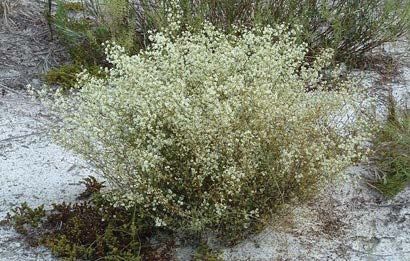Note: This fact sheet is also available as a chapter in a comprehensive manual titled Dune Restoration and Enhancement for the Florida Panhandle, available in pdf form here: https://edis.ifas.ufl.edu/pdffiles/SG/SG15600.pdf. Please see the manual for more information about other useful and attractive native plants for dunes and for further information about restoration and preservation techniques.
Polygonaceae

Credit: Kari Ruder, UF/IFAS
October flower is widespread throughout Florida and more broadly in coastal states west to Texas and northeast to Virginia. October flower is found in dune and scrub plant communities and ruderal areas. The showy flowers and attractive foliage make this native plant a desirable ornamental for landscapes.
General Description
October flower is an herbaceous short-lived perennial that can reach heights of 3 ft. Leaves are simple, alternate, linear, stipulate, 0.5 to 5 mm wide and persistent when fruit are present with veins that appear parallel and with inconspicuous secondary venation. Stipules are fused together around the stem in an entire ocrea. Branches are partly fused to the stem as if arising between the nodes. Inflorescences are prolific; racemes occur from July to October. Flowers are white to pink and contain male and female parts. They lack a corolla, have superior ovaries, and are subtended by a bract and two bracteoles. Fruit is an 0.8- to 1-mm-wide achene.
Propagation
Germination requirements of October flower are known (Heather 2009; Heather 2010). Seeds have non-deep physiological dormancy that is alleviated by warm or cold, moist stratification, application of 1,000 ppm GA (Gibberellic acid), or time in storage. Seeds prefer cooler temperatures (22/11°C) to warmer ones. Seeds collected between November and February have been successfully germinated.
Stem cutting production is possible on summer softwood stem cuttings of October flower (Heather 2009; Thetford et al. 2012). Application of auxin, such as IBA (Indole-3-butyric acid) is not needed for root initiation but may improve rooting performance. Greenhouse-grown plants perform well in both peat- and bark-based propagation media (Smith et al. 2014).
Outplanting
Greenhouse-grown plants of October flower performed well in a trial garden as a native wildflower producer for several months, with peak flowering in October (Smith et al. 2014). Beach dune outplanting information is not presently available.
Literature Cited
Heather, A.E. 2009. "A study on propagation methods for two native wildflowers: Polygonella polygama and Polygonella robusta." Master's thesis. University of Florida.
Heather, A.E. 2010. "Non-deep physiological dormancy in seeds of two Polygonella species with horticultural potential." HortScience 45(12):1854–1858.
Smith, A.M., S.B. Wilson, M. Thetford, K.L. Nolan, and C. Reinhardt Adams. 2014. "Performance of nine Florida native wildflower species grown in varying container substrates." Native Plants Journal 15(1):75–86.
Thetford, M., A.E. O'Donoughue, S.B. Wilson, and H.E. Pérez. 2012. "Softwood cutting propagation of three Polygonella wildflower species native to Florida." Propagation of Ornamental Plants 12(1): 58–62.